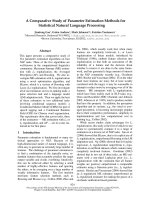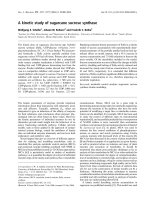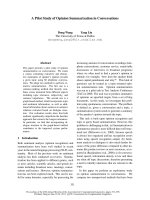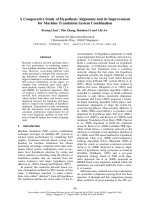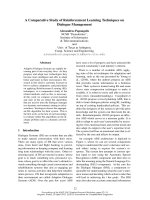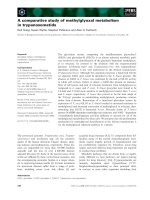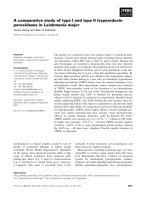báo cáo sinh học:" A cost-effectiveness study of caesarean-section deliveries by clinical officers, general practitioners and obstetricians in Burkina Faso" doc
Bạn đang xem bản rút gọn của tài liệu. Xem và tải ngay bản đầy đủ của tài liệu tại đây (266.08 KB, 12 trang )
BioMed Central
Page 1 of 12
(page number not for citation purposes)
Human Resources for Health
Open Access
Research
A cost-effectiveness study of caesarean-section deliveries by clinical
officers, general practitioners and obstetricians in Burkina Faso
Sennen H Hounton*
1,2
, David Newlands
2
, Nicolas Meda
1
and Vincent De
Brouwere
3,4,5
Address:
1
Department of HIV/AIDS & Reproductive Health, Centre MURAZ, Bobo-Dioulasso, Burkina Faso,
2
University of Aberdeen, Aberdeen,
UK,
3
Institute of Tropical Medicine, Antwerp, Belgium,
4
Institut de Recherche pour le Développement, Rabat, Morocco and
5
Institut National
d'Administration Sanitaire, Rabat, Morocco
Email: Sennen H Hounton* - ; David Newlands - ; Nicolas Meda - ;
Vincent De Brouwere -
* Corresponding author
Abstract
Background: The aim of this paper was to evaluate the effectiveness and cost-effectiveness of
alternative training strategies for increasing access to emergency obstetric care in Burkina Faso.
Methods: Case extraction forms were used to record data on 2305 caesarean sections performed
in 2004 and 2005 in hospitals in six out of the 13 health regions of Burkina Faso. Main effectiveness
outcomes were mothers' and newborns' case fatality rates. The costs of performing caesarean
sections were estimated from a health system perspective and Incremental Cost-Effectiveness
Ratios were computed using the newborn case fatality rates.
Results: Overall, case mixes per provider were comparable. Newborn case fatality rates (per
thousand) varied significantly among obstetricians, general practitioners and clinical officers, at 99,
125 and 198, respectively. The estimated average cost per averted newborn death (x 1000 live
births) for an obstetrician-led team compared to a general practitioner-led team was 11 757
international dollars, and for a general practitioner-led team compared to a clinical officer-led team
it was 200 international dollars. Training of general practitioners appears therefore to be both
effective and cost-effective in the short run. Clinical officers are associated with a high newborn
case fatality rate.
Conclusion: Training substitutes is a viable option to increase access to life-saving operations in
district hospitals. The high newborn case fatality rate among clinical officers could be addressed by
a refresher course and closer supervision. These findings may assist in addressing supply shortages
of skilled health personnel in sub-Saharan Africa.
Published: 16 April 2009
Human Resources for Health 2009, 7:34 doi:10.1186/1478-4491-7-34
Received: 20 December 2008
Accepted: 16 April 2009
This article is available from: />© 2009 Hounton et al; licensee BioMed Central Ltd.
This is an Open Access article distributed under the terms of the Creative Commons Attribution License ( />),
which permits unrestricted use, distribution, and reproduction in any medium, provided the original work is properly cited.
Human Resources for Health 2009, 7:34 />Page 2 of 12
(page number not for citation purposes)
Background
Maternal and neonatal mortality remain unacceptably
high in the developing world [1]. The risk of dying from
pregnancy-related causes in the poorest countries is 250
times that of the richest countries [2].
Several strategies have been developed to significantly
reduce these avoidable deaths, particularly the promotion
of access to and uptake of life-saving interventions [3].
These life-saving interventions are contingent on the
availability of skilled human resources. But several devel-
oping countries are faced with scarce and inadequate cov-
erage of skilled health personnel.
In Burkina Faso, as in many other developing countries,
doctors are concentrated in urban areas and there is high
turnover (internal mobility towards international organi-
zations and external brain drain) of skilled health profes-
sionals [4]. In most sub-Saharan countries, the use of
substitute health workers began as a temporary measure
while more doctors were trained, but has become a per-
manent strategy in the face of a crisis in human resources
for health. Given the current pace of training skilled
health professionals, it is unlikely that these countries will
meet adequate and equitable ratios per population in the
foreseeable future.
Subsequently, several countries have embarked on alter-
natives of training mid-level health professionals to
address the shortage of skilled health professionals and in
an attempt to contain costs [5,6]. Examples are clinical
officers in Burkina Faso (attachés de santé en chirurgie), the
Democratic Republic of the Congo, Mali, Mozambique,
Niger, Tanzania and Zambia.
In Burkina Faso, a six-month special curriculum was
designed to train district medical officers in emergency
surgery (chirurgie essentielle: essential surgery). In Niger, a
similar curriculum (médecin capacitaire) has been designed
as a one-year course for general practitioners. Graduates
can be directly admitted to the second year of training of
obstetricians or surgeons.
Another similar training programme has been developed
in Mali (médecin à tendance chirurgicale). Using mid-level
cadres as substitutes for obstetricians or surgeons appears
to be less costly and to help improve coverage of emer-
gency obstetric care in rural areas [7-9].
Although much has been written about the effectiveness
and cost of care of mid-level cadres [5-8], very few studies
have looked at the cost-effectiveness of these alternative
strategies in reducing maternal and neonatal deaths [10].
This study sought to contribute to the debate about the
delegation of surgical tasks and use of substitutes by com-
paring the effectiveness and cost-effectiveness of caesar-
ean-section deliveries in Burkina Faso by clinical officers –
registered nurses with an additional two years' training in
surgery (attachés de santé en chirurgie) – general practition-
ers trained in essential surgery and obstetricians in reduc-
ing maternal and neonatal mortality.
Methods
The context
The study was conducted in Burkina Faso, one of the
poorest countries in the world [11], with a 23% adult lit-
eracy rate and a high maternal mortality ratio estimated as
ranging from 484 per 100 000 live births [12] to 700 per
100 000 live births [13]. In 2005, the average ratios of spe-
cialists, general practitioners and midwives were 1 per 100
000, 1 per 30 000 and 1 per 25 000 inhabitants, respec-
tively [14]. These figures were worse when considering
subsets of these health personnel actually providing clini-
cal care (and not involved in other activities).
To respond to the scarcity of skilled health providers, the
government embarked in the early 1980s in training sub-
stitutes for skilled health professionals: training courses
for auxiliary midwives (accoucheuses auxiliaires), male
midwives (maïeuticiens d'état) and clinical officers
(attachés de santé) were created.
In addition, a six-month training programme in essential
surgery for medical doctors (chirurgie essentielle or essential
surgery) was initiated in the early 1990s. Recent process
evaluations of this latter programme [15,16] revealed a
high turnover of trained doctors due to lack of reward in
terms either of an increase in salary or of degree accredita-
tion, a high rate of absenteeism due to lack of motivation,
and competing administrative tasks.
Study design, sampling and participants
The study was a retrospective, cross-sectional, facility-
based survey. Data for 2004 and 2005 were collected from
hospital records and patient case notes during the last
quarter of 2007. Because of time and resource constraints,
we decided to collect data from all public sector facilities
providing caesarean sections in six of the 13 regions of the
country (22 hospitals). These six regions were conven-
iently selected to account for major socioeconomic and
cultural differences in the country. Participants in the
study were providers of caesarean section, such as special-
ists (obstetricians or surgeons), trained general practition-
ers, clinical officers, support staff, policy-makers, and
maternal and child health programme managers.
Data collection
Data were collected by a survey team composed of two
public health specialists and former district medical offic-
ers, three health economists, three sociologists and a mid-
Human Resources for Health 2009, 7:34 />Page 3 of 12
(page number not for citation purposes)
wife. Case extraction forms were used to systematically
record data on caesarean sections from operating theatre
books and delivery registers. The case extraction forms
were pretested in a separate district hospital and pilot-
tested before wider use in the selected study areas. Data
were collected from each facility on number of caesarean
sections, providers, referral status of cases, diagnosis at
admission, interventions performed, survival outcomes
for mothers and babies, postoperative complications
(wound infection, haemorrhage, wound dehiscence),
duration of operation, duration of postoperative inpatient
days and type of anaesthetic.
Data were collected on the costs of putting together surgi-
cal teams to perform caesarean sections led by obstetri-
cians, general practitioners or clinical officers. These data
included annual salary, allowances, pension, training and
deployment, and time spent on surgical tasks. In addition,
data were collected from the university on the duration of
training and from the Ministry of Health on the number
of medical officers trained in emergency surgery at district
level. Finally, interviews were conducted with providers
and their surgical teams, policy-makers and programme
managers on barriers and facilitators for the essential sur-
gery training strategy.
Costing assumptions
The main assumptions made in costing relate to the time
of surgical team members and volume of caesarean sec-
tions, compared to other medical and surgical interven-
tions, so as to determine the proportion of total costs
attributable to caesarean sections (compared to other
activities). The proportion of time spent by clinical offic-
ers on caesarean sections was approximated by assuming
that clinical officers spend their entire time in surgical
units and by dividing the number of caesarean sections by
the total number of surgeries performed in 2006.
A self-administered time allocation form was used to
approximate the proportion of time spent by trained phy-
sicians on caesarean sections compared to other activities
(clinical and administrative). For non-surgical personnel
(nurses, midwives, drivers, cooks, guards, etc.) and other
hospital costs (mortuary, cleaning, motorcycles, etc.), we
used an estimate of 2% to apportion costs to caesarean
sections. Finally, the proportion of laboratory and operat-
ing theatre costs attributable to caesarean sections was
estimated at each facility by dividing the volume of caesar-
ean-related laboratory exams and operations by total lab-
oratory exams and total life-saving surgeries for mothers,
respectively.
The different discounting periods used are derived from
the average times spent in public service after graduation
by providers, assuming they remain in public service until
retirement. As an example, a nurse could potentially work
for 30 years after graduation, since, at the time the survey
was conducted, retirement was at 55 years of age or after
30 years of public service. Clinical officers could poten-
tially work 20 years, given that most clinical officers return
to further training after an average eight to 10 years of
nursing practice. The training of physicians in essential
surgery was discounted over five years, because this is the
minimum period of public service before they can seek
specialized training. None of the trained physicians
missed the opportunity to enhance their career by moving
to public health training or a clinical speciality.
Data analysis
Descriptive statistics were used to compute rates and
ratios for each type of provider. Confidence intervals were
constructed around each estimate. This was the preferred
approach, since we wished to include all caesarean sec-
tions from district hospitals in the analysis. Case mixes by
each type of provider were assessed by analysing the rela-
tionship of the key effectiveness measure with providers,
adjusting for reported diagnosis and referral status (a
proxy for the severity of cases).
We calculated cost estimates of strategies (surgical teams
led by obstetricians, trained general practitioners or clini-
cal officers at district hospitals) per selected outcomes,
employing a health service perspective. The costing exer-
cise was carried out for 2006. We estimated the costs of
caesarean sections carried out by surgical teams led by
each of the three providers, since we are seeking to com-
pare strategies, the combinations of provider, surgical
team and technical support. This approach was preferred
because, apart from patients' clinical condition at admis-
sion, the outcomes of life-saving interventions depend on
providers' skills and the presence of an adequate team,
required drugs and functioning equipment.
Training costs were annualized, at a discount rate of 3%,
so that they could be added to the other health human
resource costs to derive a measure of the annual costs of
putting together surgical teams to provide caesarean sec-
tions. The next step was to apply the appropriate proxies
of time of surgical team members so as to determine the
proportion of total costs attributable to caesarean sec-
tions, compared to other activities. Incremental cost-effec-
tiveness ratios were computed by dividing the differences
in average costs of putting in place a surgical team led by
one type of provider compared to an alternative option by
the differences in newborn case fatality rates associated
with each option. Sensitivity analysis was conducted on
the major cost categories.
We divided the average cost of putting in place an obste-
trician/general practitioner/clinical officer-led surgical
Human Resources for Health 2009, 7:34 />Page 4 of 12
(page number not for citation purposes)
team by the average number of caesarean sections per-
formed at the district hospitals in 2006. We considered
this latter measure the closest approximation of average
throughput across the whole country. Implicit in our anal-
ysis was that variable costs would be the same for an
obstetrician-led team, a general practitioner-led team, and
a clinical officer-led team. In fact, the main element of var-
iable costs is the cost of kits and this cost is borne by
patients (although subsidized by the government since
October 2006) and therefore not included in our costing,
which is from a health service perspective.
The costing exercise was conducted in West African CFA
(Communauté financière d'Afrique – Financial Community
of Africa) francs, the currency of Burkina Faso. Key results
were then translated into international dollars, which are
United States dollars adjusted for differential purchasing
power. In 2006, one international dollar equalled 181
CFA.
Results
Case profile and effectiveness of caesarean-section
deliveries
Table 1 describes the profile of 2305 cases, postoperative
complications and the duration of postoperative hospital
stay, by type of provider. It is important to clarify here that
the clinical diagnoses in Table 1 are not indications for
caesarean sections, but the diagnoses as indicated in
records after surgery. There were no significant differences
in maternal age, the clinical indications for caesarean
delivery and postoperative complications such as haemor-
Table 1: Profile of caesarean deliveries by type of provider, Burkina Faso, 2004–2005
Type of providers
Characteristics
Obstetricians
N = 1020*
Trained doctors
N = 552*
Clinical officers
N = 733*
Place (% within facilities)
National hospitals 53 3 0
Regional hospitals 17 2 41
District hospitals 30 95 59
District hospitals (% rural versus urban)
Urban** 86 5 27
Rural 14 95 73
Mother's age
Median (IQR) 25 (10) 24 (12) 25 (12)
Indication of surgical procedure (%)
Saving mother's life 74 75 81
Saving baby's life 24 21 17
Other 2 4 2
Mothers' reported conditions (%)
Obstructive labour 39 51 53
Ruptured uterus 11 7 11
Eclampsia 7 1 2
Haemorrhage 5 6 6
Other 38 35 28
Type of anaesthesia (%)
General 81 30 59
Spinal anaesthesia 19 70 41
Referral status (%)
Referred from other facilities 85 77 71
Referred by provider to higher level facility 15 23 29
Duration of caesarean-section (minutes)
Mean (SD) 46 (20) 57 (27) 53 (23)
Duration of post operative hospital stay (days)
Mean (SD) 6 (5) 9 (5) 9 (6)
Post operative complications (/000)
Haemorrhage 15 18 20
Wound infection 11 4 14
Wound dehiscence 4 0 1
* Counts were for a complete year at district hospitals.
** Only three districts (all urban) had obstetricians at the time of the survey, and only one (District Secteur 30) was fully functional with regard to
obstetric surgery. A quarter of the caesarean delivery case notes were extracted by the data collection team.
Human Resources for Health 2009, 7:34 />Page 5 of 12
(page number not for citation purposes)
rhage, wound infection and wound dehiscence (results
not shown).
Clinical officers and trained general practitioners perform
most emergency obstetric surgery at district hospitals, and
obstetricians and surgeons practise in the three urban dis-
trict hospitals and at the regional and national levels. On
average, 50% of cases dealt with at district hospitals by
clinical officers and trained general practitioners are
obstructive labour, compared with less than 40% for
obstetricians.
There was a significant difference in the percentage of
eclampsia, though the overall proportion of such cases is
small (6%). Similarly, there was a 20% shorter duration
for the operation and a 30% shorter duration of postoper-
ative hospital stay with obstetricians. Obstetricians were
also more associated with referred cases (a proxy for the
severity of cases and delay in gaining access to care), but
this difference is not statistically significant (results not
shown).
Figure 1 presents the case fatality rates (CFR) for newborns
and mothers after caesarean deliveries, by type of pro-
vider. The CFR for newborns was significantly higher for
clinical officers (198 per 1000 compared, to 99 for obste-
tricians and 125 for trained general practitioners). Simi-
larly, there seems to be a difference in CFR of mothers,
with higher mortality associated with clinical officers,
although statistical significance was not reached.
Facilitators and barriers to the essential surgery strategy
Analysis of interviews with obstetricians, trained doctors,
clinical officers, surgical aides and policy-makers revealed
that the delegation of surgical skills to mid-level cadres
(trained doctors, clinical officers) was necessary and has
been useful in increasing access to life-saving interven-
tions for women and babies. However, most trained doc-
tors are often out of hospital for administrative duties and
tend to move into public health training on average five
years after their essential surgery training. The regulation
is that any public servant can seek continuing education
five years after being hired. According to the interviews,
the reasons for rapid turnover were the absence of incen-
tives to remain in post (no supervision, no increase in sal-
ary and no clear career path).
Costing caesarean sections by type of provider
Table 2 shows the annual training and deployment costs
of providers. The annual training cost of an obstetrician
was estimated at 1.49 million CFA, or 8231 international
dollars, 30% higher than the training costs of a trained
doctor (1.04 million CFA, 5747 international dollars) and
over 80% higher than the training costs of a clinical officer
(0.27 million CFA, 1480 international dollars).
Table 3 shows the annual costs of putting together surgical
teams to provide caesarean sections for each of the district
hospitals. The annual cost of each surgical team varied sig-
nificantly by type of provider and among district hospitals
for a specific provider. As an illustration, the annual cost
of an obstetrician-led team was 1 213 239 CFA or 6703
international dollars in Pissy district hospital, 38 times
the cost in Secteur 30 district hospital (31 696 CFA, or 175
international dollars). These large economies of scale are
also illustrated by the significant difference in annual
costs of general practitioner-led teams between Boulsa
and Bogande, two remote, rural district hospitals.
The upper part of Table 4 shows the total cost to the health
system of caesarean sections by surgical team. The average
total cost of obstetrician-led teams was 8.58 million CFA,
or 47391 international dollars, the average of the three
district hospitals where there are obstetricians. The corre-
sponding estimate of general practitioner-led teams was
3.47 million CFA, or 19 154 international dollars, the
average of the 15 district hospitals where there are trained
general practitioners. The average total cost of clinical
officer-led teams was 3.22 million CFA, or 17 803 interna-
tional dollars, the average of the 13 district hospitals
where clinical officers conducted caesarean sections.
The large difference between the cost of obstetrician-led
teams and general practitioner-led teams is due partly to
the costs of training and remuneration of obstetricians but
mostly to the greater support available, in terms of other
personnel, at the urban district hospitals where obstetri-
cians are to be found. In contrast, the (smaller) difference
between the cost of general practitioner-led teams and
clinical officer-led teams is due largely to the greater costs
of training and remuneration of general practitioners.
We estimated the average cost per caesarean section to be
92 858 CFA (513 international dollars) per caesarean sec-
tion conducted by obstetricians, 37 531 CFA (207 interna-
tional dollars) for general practitioners and 34 884 CFA
(193 international dollars) for clinical officers. These are
all large figures, but they reflect the small number of cae-
sarean sections performed at district hospitals – indeed all
hospitals – in Burkina Faso. If the average number of cae-
sarean sections performed by any of the surgical teams
increased, the average cost per caesarean section would
fall correspondingly. Very significant economies of scale
could be achieved within the existing capacity of district
hospitals. Indeed, if the average number of caesarean sec-
tions performed at district hospitals were to double, we
would expect the cost per caesarean section to halve.
Cost-effectiveness analysis
The lower part of Table 4 presents the Incremental Cost
Effectiveness Ratio (ICER) of adverse outcomes for new-
Human Resources for Health 2009, 7:34 />Page 6 of 12
(page number not for citation purposes)
Case fatality rates of caesarean deliveries by provider, district hospitals, Burkina Faso, 2004–2005Figure 1
Case fatality rates of caesarean deliveries by provider, district hospitals, Burkina Faso, 2004–2005.
a) Newborn
b) Mother
0
10
20
30
40
50
60
70
80
Obstetricians General practitioners Clinical officers
Maternal case fatality rates (N/1000)
0
50
100
150
200
250
Obstetricians General practitioners Clinical officers
Newborns case fatality r ates (N/1000)
Human Resources for Health 2009, 7:34 />Page 7 of 12
(page number not for citation purposes)
Table 2: Annual training and deployment costs of providers of caesarean deliveries, Burkina Faso, 2006
Clinical officers Costs (CFA)
Basic clinical officers training (discounted over 30 years) cost/resident
1
73 127
Clinical officers training costs (discounted over 20 years) 194 768
Total clinical officers training costs 267 895
Enhanced clinical officers training*
Discounted basic clinical officers training (discounted over 20 years) cost/resident
1
73 127
Clinical officers training costs (discounted over 20 years) 194 768
Refresher course** (discounted over 2 years) * 313 589
Total enhanced clinical officers training costs 581 484
Trained doctors in essential surgery
Basic training (discounted over 30 years) cost per doctor 135 171
Surgery training costs (discounted over 5 years)
5
904 983
Total essential surgery training costs 1 040 153
Enhanced essential surgery training*
Basic training (discounted over 30 years) cost per doctor 135 171
Enhanced surgery training costs (discounted over 15 years)
5
1 296 608
Total enhanced surgery training costs 1 431 779
Specialists (obstetricians and surgeons)
Basic training (discounted over 30 years) cost per doctor 135 171
Obstetricians' training costs (discounted over 20 years)
7
1 354 650
Total obstetricians' training costs 1 489 821
1
From nursing school budget, 2005, numbers of students (all residents, all majors, % clinical officers), national contest for clinical officers, discounted
over 30 years
2
Source: Human resources division, health personal salaries.
3
Discounted over 20 years
4
From University of Ouagadougou budget, School of Health Sciences (% of medical students among all students), national contest, discounted over
30 years
5
Source: Ministry of Health, discounted over five years (average duration of practice of essential surgery)
6
From University of Ouagadougou budget, School of Health Sciences (% of medical students among all students), national contest
7
Discounted over 20 years (estimated duration of practice of obstetrician)
* See Table 4
** Estimated refresher course and supervision costs, discounted over two years (clinical officers to attend two month refresher course every two
years)
Human Resources for Health 2009, 7:34 />Page 8 of 12
(page number not for citation purposes)
borns after a caesarean delivery, by type of provider. These
figures can be interpreted as the additional cost of saving
a newborn's life, moving from one provider to another.
For example, subtracting the average cost of 1000 caesar-
ean sections performed by general practitioners from that
performed by obstetricians (92 858 million minus 37 531
million CFA) and dividing by the difference in perform-
ance (125 minus 99 newborn CFR per 1000 caesarean sec-
tions) gives an ICER of 2 127 962 CFA. This means that
the cost of avoiding one additional newborn death when
1000 caesarean deliveries are performed by an obstetri-
cian instead of a trained doctor is 2 127 962 CFA, or 11
757 international dollars. The ICER of caesarean sections
performed by an obstetrician rather than a clinical officer
is 585 596 CFA, or 3235 international dollars, and of cae-
sarean sections performed by a general practitioner rather
than a clinical officer, 36 260 CFA, or 200 international
dollars.
There is no agreed threshold value above which an option
would be considered unacceptable. Nevertheless, while
we may not be able to decisively reject any option as not
being cost-effective, taken together our results are indica-
Table 3: Annual costs of caesarean deliveries by type of provider teams at district hospitals, Burkina Faso, 2006
Cost of provider-led surgical team
District hospitals Obstetricians General practitioners Clinical officers Number of
c-sections*
Barsalogo - 6 078 044 5 691 552 37
Bogande - 3 970 104 3 604 590 56
Boromo - 5 023 738 4 565 343 144
Boulsa - 2 253 927 1 889 286 4
Diebougou - 1 693 474 1 301 525 51
Diapaga - 1 829 962 1 466 812 81
Houndé - 3 328 228 2 958 590 112
Kongoussi - 4 443 142 4 079 992 27
Kossodo** 1 142 510 616 192 - 11
Nouna - 3 365 654 1 457 758 42
Orodara - 3 595 155 3 041 070 89
Pama - 1 895 451 1 513 389 12
Pissy** 3 639 716 2 576 760 - 3
Secteur 30** 20 950 981 - - 661
Solenzo - 3 855 850 2 893 375 87
Tougan - 7 482 383 7 058 708 61
Mean 8 577 736 3 466 938 3 222 433 92.375
* From a prospective data collection on caesarean-sections per district hospital, during 2006
** Urban district hospitals
Human Resources for Health 2009, 7:34 />Page 9 of 12
(page number not for citation purposes)
tive of the effectiveness and cost-effectiveness of trained
general practitioners.
Table 5 presents results of a simple modelling of the
enhanced training and consequent better performance of
general practitioners and of clinical officers. In addition,
we assumed that turnover would be reduced and more
career development opportunities provided for general
practitioners. A two-year training programme would
improve quality of care and would qualify doctors for an
Table 4: Incremental cost-effectiveness ratios of caesarean deliveries by providers' teams, district hospitals, Burkina Faso, 2006
Providers
(Surgical teams led by )
Total costs of surgical team Cost per c-section, CFA Newborns CFR
(/1000 c-sections)
Obstetricians (O) 8 577 736 92 858 99
Trained doctors (D) 3 466 938 37 531 125
Clinical officers (CO) 3 222 433 34 884 198
Incremental Cost-Effectiveness Ratio (ICER) = incremental
cost of performing 1000 c-sections/incremental gain of
newborns' lives per 1000 c-sections
ICER from (D) to (O) = (92.858 mi-37.531 mi)/(125-99) 2 127 962
ICER from (CO) to (O) = (92.858 mi-34.884 mi)/(198-99) 585 596
ICER from (CO) to (D) = (37.531 mi-34.884 mi)/(198-125) 36 260
Table 5: Incremental cost-effectiveness ratios of caesarean deliveries by providers' teams, enhanced strategies*, district hospitals,
Burkina Faso, 2006
Providers
(Surgical teams led by )
Total costs of surgical team Cost per c-section (CFA) Newborns CFR
(/1000 c-sections)
Obstetricians (O) 8 577 736 92 858 99
Trained doctors (D) 4 205 141 45 523 112**
Clinical officers (CO) 3 796 782 41 102 161.5***
Incremental Cost-Effectiveness Ratio (ICER) = incremental
cost of performing 1000 c-sections/incremental gain of
newborns' lives per 1000 c-sections
ICER from (D) to (O) = (92.858 mi-45.523 mi)/(112-99) 3 641 154
ICER from
(CO) to (O) = (92.858 mi-41.102 mi)/(161.5-99)
828 096
ICER from
(CO) to (D) = (45.523 mi-41.102 mi)/(161.5-112)
89 313
* Enhanced strategies = enhanced essential surgery and enhanced clinical officers
"Enhanced essential surgery" = two years' degree-seeking training, salary incidence, incentives (management at district level, allowances for living
conditions in remote areas, and possibility to directly join obstetricians' or surgeons' training class with validation of first year); assumptions of 15
years' practice, and advantage of not losing critical life saving to public health training and practice
"Enhanced clinical officers" = current clinical officers subjected every two years to a refresher course coupled with an effective supervision
programme
** Hypothetical figure of outcomes of "enhanced essential surgery" after two year training programme
*** Hypothetical figure of outcomes of "enhanced clinical officers" after refresher courses and effective supervision
Human Resources for Health 2009, 7:34 />Page 10 of 12
(page number not for citation purposes)
increase in salary within Burkina Faso's public health sys-
tem. A benefit package of such enhanced training would
address barriers to current essential surgery training and
would include management responsibilities at district
level, allowances for living conditions in remote areas and
a career path opportunity to directly join the training class
of obstetricians or surgeons with the automatic validation
of the first year of study.
The costs of putting in place a general practitioner-led sur-
gical team rise as a consequence of the increased training
period, from 3.47 million CFA, or 19 154 international
dollars, to 4.21 million CFA, or 23 233 international dol-
lars. Performance can be assumed to improve as a result of
greater skills and commitment, but there is no way to
determine what the improvement will be. We assume that
half the previous gap in performance between obstetri-
cians and trained general practitioners would be closed –
that the newborn CFR (per 1000 caesarean sections) for
trained general practitioners would fall from 125 to 112.
We now assume that trained doctors have an incentive to
remain in service performing caesarean sections for
longer, and that they do so for 15 years (as opposed to five
years previously).
For clinical officers, we model an enhancement of their
training, consisting of a refresher course every two years
and more effective supervision. The costs of putting in
place a clinical officer-led surgical team rise as a conse-
quence, from 3.22 million CFA, or 17 803 international
dollars, to 3.80 million CFA, or 20 977 international dol-
lars. Again, performance can be assumed to improve but
we cannot say what the improvement would be. However,
following the same approach as before, we assume that
half the previous gap in performance between trained
general practitioners and clinical officers would be closed
– that the newborn CFR (per 1000 caesarean sections) for
clinical officers would fall from 198 to 161,5.
As can be seen from Table 5, all the Incremental Cost-
Effectiveness Ratios (ICERs) increase. The most important
change is the ICER from general practitioners to obstetri-
cians, which increases from 2 127 962 CFA, or 11 757
international dollars, to 3 641 154 CFA, or 20 117 inter-
national dollars. This is further evidence of the cost-effec-
tiveness of trained general practitioners.
Discussion
Within the limits of comparability of the different config-
uration of surgical teams led by each type of provider, it
appears that both training clinical officers and general
practitioners, particularly the latter, are viable options to
increasing coverage of emergency obstetric care in district
hospitals. Training of general practitioners appeared effec-
tive and cost-effective. Levels of performance could be
increased further by improving the supervision of clinical
officers and providing trained doctors with stronger
incentives, such as better career opportunities.
Despite the importance of these findings, some limita-
tions of the study should be acknowledged. We sought to
compare outcomes of caesarean sections among three dif-
ferent types of surgical team, led by an obstetrician, a
trained general practitioner or a clinical officer. This was
deemed necessary because it is technically difficult to
assume comparability of scope, skills and leadership
among the providers and it is also difficult to use emer-
gency obstetric care, a more complex entity, as an output
without taking into account the detailed case mix.
Our approach therefore was to compare outputs of caesar-
ean sections at district hospital level. The construction and
equipment of district hospitals are standardized in
Burkina Faso [17], albeit urban district hospitals are better
equipped.
The ability to perform caesarean sections was used as a
proxy for the ability to perform life-saving obstetric sur-
gery, an assumption that may be flawed because of differ-
entials in skills to perform life-saving interventions. Also,
the reliability of our main effectiveness measure, newborn
case fatality rates, suffered from lack of precision on the
timing of deaths, which would have been useful in associ-
ating deaths with surgical teams or monitoring of the
labour. We assumed that deaths of newborns following
caesarean sections are associated with the management of
cases by health teams at hospital level, which may not
always be the case.
Finally our operational approach to assess the compara-
bility of cases by type of provider was to adjust for
reported diagnosis after surgery and by referral status (a
proxy for delay in accessing care and severity). The relia-
bility of this approach may be limited for a retrospective
study.
The duration of operations and postoperative hospital
stay was 10% and 30% shorter, respectively, with obstetri-
cians, probably reflecting their better skills and practices
in obstetrics. Also, obstetricians were more associated
with referred cases and eclampsia, because more severe
cases are referred to higher-level facilities where obstetri-
cians and surgeons are more likely to practise. The
observed differences reflect more the differences in
resources available at each level of the health system. As
an illustration, providers will rely on spinal anaesthesia in
remote areas that lack a resuscitation system and intensive
care unit, while at regional and national hospitals the pre-
ferred means of induction will be general anaesthesia.
Human Resources for Health 2009, 7:34 />Page 11 of 12
(page number not for citation purposes)
Beyond the issue of comparability of cases, a more rigor-
ous approach would have taken into account indication
and relevance for caesarean sections, delay in reaching the
decision to operate, delay between the decision to operate
and actual interventions, and the clinical condition of
mothers and unborn babies on arrival at hospital [18].
Unfortunately, retrospective records are deficient and a
prospective data collection was beyond the scope of this
study. It is therefore difficult to reliably attribute adverse
outcomes to configurations of providers. Any inferences
should thus be made with caution.
For the foreseeable future, these categories of health pro-
fessionals will remain the only available resources in
remote and rural settings in Burkina Faso and it is crucial
that quality of care be ensured. Experience from other set-
tings of using substitutes for skilled health professionals
led to the conclusion that these strategies may be the only
options to increase coverage of life-saving procedures in
the short or medium term [7-9]. However, given the scar-
city of resources, policy-makers should embark on the
most cost-effective strategies and therefore these strategies
should be weighed against health gain in terms of pre-
venting deaths of mothers and newborns.
The overall CFRs are too high, irrespective of providers of
caesarean sections, if the country is to meet the targets of
Millennium Development Goals Four (to reduce child
mortality) and Five (to improve maternal health). Vaz et
al. have reported similar rates (0.4%) of postoperative
maternal mortality in emergency interventions by medical
assistants in Mozambique [5]. Unlike the experience of
Mozambique and Malawi with clinical officers [7,10],
postoperative maternal and neonatal mortality rates in
our study were not comparable to those of trained general
practitioners or obstetricians. The excess of mortality of
newborns and mothers with clinical officers indicates the
need for refresher courses and better supervision for clini-
cal officers if maternity care is to be improved.
Conclusion
Based on the observed level of performance of providers
of caesarean sections, trained general practitioners appear
to be the most cost-effective option for increasing cover-
age of maternal life-saving interventions. Their cost-effec-
tiveness could be further increased if they are provided
with better career paths and if incentives for general prac-
titioners resulted in further improvements in their per-
formance (Table 5). Given that Burkina Faso will not have
the required rates of skilled health professionals in the
short run, delegation of surgical tasks from specialists to
middle-level health substitutes appears necessary and
effective. These findings may assist other sub-Saharan
African countries to address supply shortages of skilled
health personnel.
Competing interests
The authors declare that they have no competing interests.
Authors' contributions
SHH was the principal investigator of the grant. He led
data collection and data management; performed the
analysis; drafted and finalized the manuscript. DN con-
tributed to the conception of the grant and assisted with
study design; performed data analysis; and contributed to
the interpretation and writing of the manuscript. NM con-
tributed to the conception of the grant; assisted with study
design, data analysis and interpretation and intellectual
content of the manuscript. VDB contributed to the con-
ception of the grant, assisted with data analysis and inter-
pretation and writing of the manuscript.
Acknowledgements
This work was conducted through the grant WAHO Centre MURAZ Pro-
posal No 13. The authors would like to thank the West Africa Health
Organization (WAHO) for the grant and the Ministry of Health and local
authorities in Burkina Faso for facilitating the implementation of the study.
The authors are also grateful to Danielle Belemsaga, Fadima Bocoum,
Cecile Tamini, Mamadou Barro and Romaric Some for data collection;
Moctar Ouedraogo, Peter Byass and Danielle Belemsaga for assistance with
data management and analysis; and Issiaka Sombie for valuable comments
on the report of the evaluation. The funder and institutions have no respon-
sibility for the information provided and the views expressed herein are
solely those of the authors.
References
1. Graham W: The Scandal of the Century. Br J Obstet Gynaecol
1998, 105:375-376.
2. Campbell OM, Graham WJ: Strategies for reducing maternal
mortality: getting on with what works. Lancet Maternal Sur-
vival Series steering group. Lancet 2006, 368(9543):1284-1299.
3. Bullough C, Meda N, Makowiecka K, Ronsmans C, Achadi EL, Hussein
J: Current strategies for the reduction of maternal mortality.
BJOG 2005, 112:1180-1188.
4. Dovlo D: Using mid-level cadres as substitutes for interna-
tionally mobile health professionals in Africa. A desk review.
Human Resources for Health 2004, 2:7.
5. Vaz F, Bergström S, Vaz Mda L, Langa J, Bugalho A: Training medi-
cal assistants for surgery. Bull World Health Organ 1999,
77(8):688-691.
6. Pereira C, Bugalho A, Bergström S, Vaz F, Cotiro M: A comparative
study of caesarean deliveries by assistant medical officers
and obstetricians in Mozambique. Br J Obstet Gynaecol 1996,
103(6):508-512.
7. Pereira C, Cumbi A, Malalane R, Vaz F, McCord C, Bacci A, Berg-
ström S: Meeting the need for emergency obstetric care in
Mozambique: work performance and histories of medical
doctors and assistant medical officers trained for surgery.
BJOG 2007, 114(12):1530-1533.
8. Kruk ME, Pereira C, Vaz F, Bergström S, Galea S: Economic evalu-
ation of surgically trained assistant medical officers in per-
forming major obstetric surgery in Mozambique. BJOG 2007,
114(10):1253-1260.
9. Kowalewki M, Jahn A: Health professionals for maternity serv-
ices: Experiences on covering the population with quality
maternity care. Studies in Health Services Organisation and Policy
2001, 17:131-150.
10. Chilopora G, Pereira C, Kamwendo F, Chimbiri A, Malunga E, Berg-
ström S: Postoperative outcome of caesarean sections and
other major emergency obstetric surgery by clinical officers
and medical officers in Malawi. Hum Resour Health 2007, 5:17.
11. Human Development Index [ />data_sheets/cty_ds_BFA.html]
Publish with Bio Med Central and every
scientist can read your work free of charge
"BioMed Central will be the most significant development for
disseminating the results of biomedical research in our lifetime."
Sir Paul Nurse, Cancer Research UK
Your research papers will be:
available free of charge to the entire biomedical community
peer reviewed and published immediately upon acceptance
cited in PubMed and archived on PubMed Central
yours — you keep the copyright
Submit your manuscript here:
/>BioMedcentral
Human Resources for Health 2009, 7:34 />Page 12 of 12
(page number not for citation purposes)
12. National Institute of Statistics and Demography (INSD), and Macro
International Inc: Demographic and Health Survey. Burkina Faso 2003
Calverton, Maryland (USA): Macro International Inc; 2004.
13. Maternal mortality in 2005: Estimates developed by WHO,
UNICEF, UNFPA and World Bank. World Health Organiza-
tion. ISBN 978 92 4 159621 3 (NLM classification: WQ 16)
14. Ministry of Health, Burkina Faso: Annual health statistics. Ouagadougou
2005.
15. Diarra-Nama AJ: Evaluation de la chirurgie essentielle Ouagadougou:
CADSS, Ministère de la Santé; 2001.
16. Zoungrana T: Bilan de la Formation et de la Supervision des
médecins formés en chirurgie essentielle. In Table ronde sur la
problématique des CMA Ouagadougou: CADSS, Ministère de la Santé;
2004.
17. Ministère de la Santé: Direction des Infrastructures des Equipements et de
la Maintenance (DIEM). Normes et standards en infrastructures et en
équipements du Centre de Santé et de Promotion Sociale, du Centre Médi-
cal avec Antenne Chirurgicale et du Centre Hospitalier Régional. Ouaga-
dougou 2004.
18. Ouédraogo C, Zoungrana T, Dao B, Dujardin B, Ouédraogo A,
Thiéba B, Lankouande J, Koné B: La césarienne de qualité au
Centre Hospitalier Yalgado Ouédraogo de Ouagadougou.
Analyse des déterminants à propos de 478 cas colligés dans
le service de gynécologie obstétrique. Médecine d'Afrique Noire
2001, 48(11):442-451.

